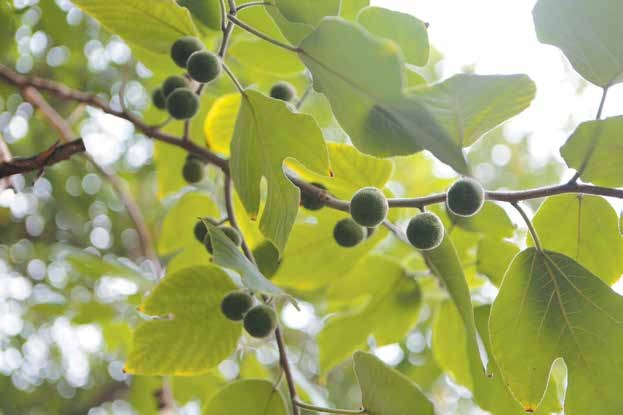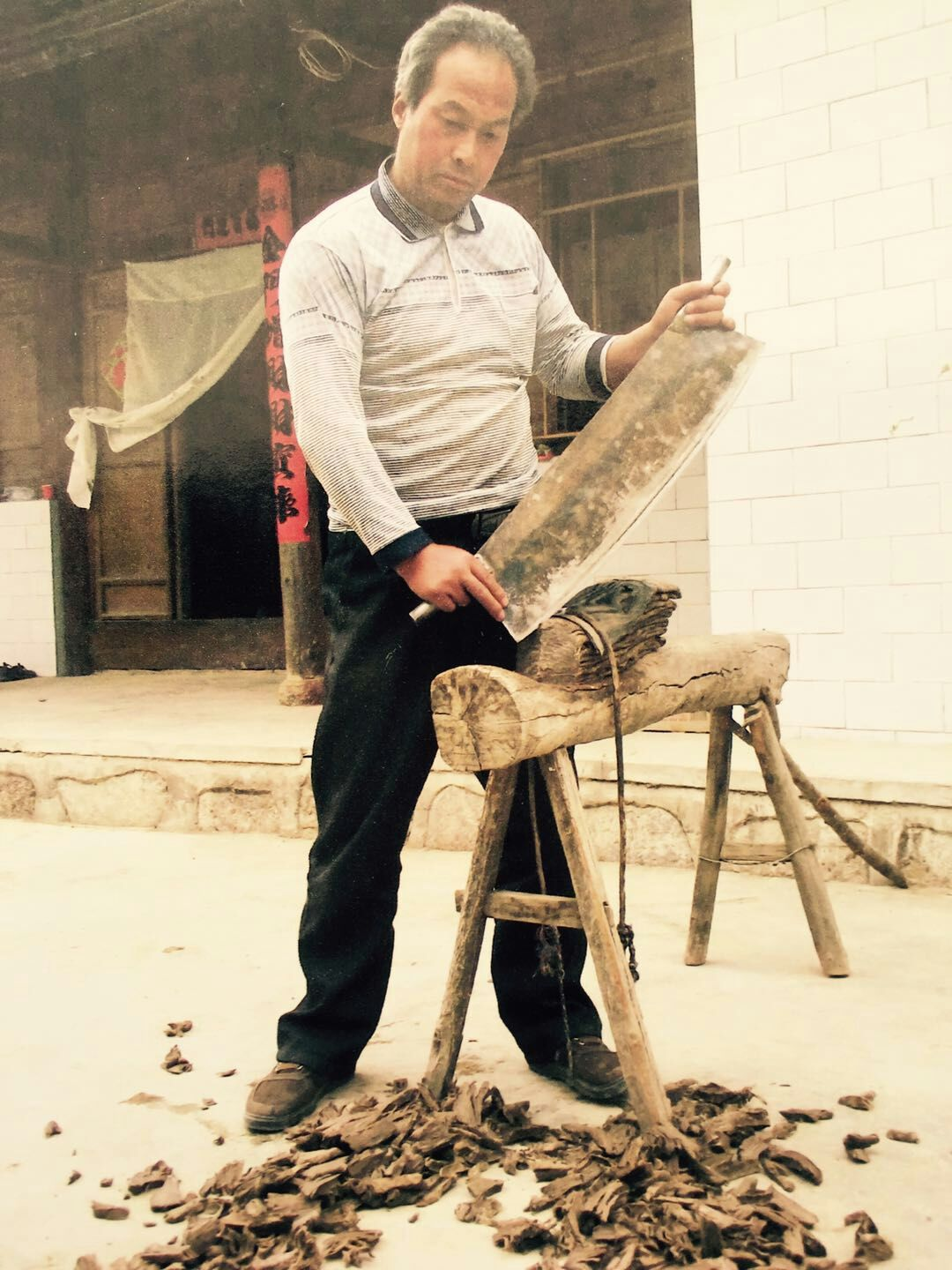Key Figures



Harvested for 15-20 years 2.5-3 tonnes yearly RMB6,000 of value per mu per year
A deciduous shrub or tree that usually grows to a height of 10 to 20 metres, paper mulberry's (Broussonetia papyrifera) role in human history has spanned millennia. The plant's bark is one of the main raw materials that Cai Lun used in his papermaking when he revolutionised the process in the year 105 CE, which is considered one of the four great inventions of ancient China alongside printing, gunpowder and the compass.
Known for its ability to survive both the cold climate of northern China and the heat in the south as well as high level of adaptability and wide distribution in general, paper mulberry's tolerance to various environments enables it to grow nearly anywhere from the mountainous terrain of Gansu Province to the farms of tropical Hainan Island. Its leaves can be used to feed pigs, cows, sheep, and other livestock, and its bark can be made into medicine, textiles, and other products in addition to paper.

A view of a paper mulberry tree.
The species has become an important resource for impoverished communities in rural China due to the fact that its leaves can be used as high-quality animal feed, its bark can be used to make paper and other products, and its roots and other features can enhance the natural environment.
In 2015, the State Council Leading Group Office of Poverty Alleviation and Development launched ten large-scale targeted poverty alleviation projects in 11 regions across China, one of which consisted of growing paper mulberry plants for profit.
The government of Wuchuan Gelao and Miao Autonomous County, Zunyi City, Guizhou Province, established a paper mulberry hybridisation centre with the Institute of Botany under the Chinese Academy of Sciences (the country's national academy for natural sciences as well as a scientific think tank and academic governing body) with the aim of establishing an efficient supply chain and expanding the non-timber forest product (NTFP) industry for the paper mulberry project.
The Institute of Botany has been conducting research into the crossbreeding of the paper mulberry species since 2002 as part of a campaign to solve China's demand for high-protein animal feed. The organization evaluated the paper mulberry and several other plant species and discovered that animal feed with high crude protein content can be produced when the tree is hybridised. The R&D that it engaged in ultimately led to the creation of a species that is hardy, grows quickly, has strong tillering ability, can be harvested 3-5 times a year for up to 15-20 years, and has other useful characteristics.
The plant had been planted on 2,000 mu of formerly barren hills and other land in Wuchuan's Fengle Township by early 2017. A representative from the Wuchuan Agriculture and Animal Husbandry Bureau noted that RMB3,000's worth of seedlings per mu and sufficient organic fertiliser are the main costs of getting started. The approximately 2.5-3 tonnes of dried paper mulberry material that can be harvested per mu on an average year sell for a total average of more than RMB6,000. Most start-up expenses can, therefore, be recovered within a year based on these numbers.
Chen Yuanzhou, a Fengle resident who was impoverished prior to growing the paper mulberry, stated that his family earned a little more than RMB1,000 per mu per year from the corn they were growing in the past, but noted that they earned more than RMB10,000 within a year of establishing a 3-mu paper mulberry plot.
A myriad of uses
Livestock farmers who live in the areas where the project has been implemented have been encouraged to feed paper mulberry leaves to their pigs, sheep, cattle, and poultry, and the meat that the people who do so produce has been marketed to the public. Lean paper mulberry leaf-fed pork was sold in dozens of supermarkets in south China's Guangxi Zhuang Autonomous Region for RMB62 per kg in 2016 for example, which was more than double the RMB26 average price per kg that existed for pork at the time. The product has been popular with consumers in spite of its price due to the fact that increasing numbers of Chinese citizens have been looking for greener products that meet higher food-safety standards.
Paper mulberry also has many other useful properties in addition to producing leaves that can be used as feed. It can help control soil salinity, prevent erosion and desertification, and is very adaptable in general. The tree's robust system of roots enables it to thrive in areas with rocky karst topography that retain little water and help reduce dust and air pollution. It is also a pioneer plant species in areas with high heavy metal content due to its considerable capacity to absorb various heavy metals, which makes it suitable for phytoremediation and afforestation.
Some 900 km away from Guangxi, Liuhe and Zhuhe are two small neighbouring villages with a combined population of 700 in the mountainous Xigaoshan Township, of Xihe County in Longnan City, Gansu Province. The people there have a tradition of making paper by hand using the bark of the paper mulberry tree.
A resident of the area named Hu Fengyu noted that locals burned the paper as part of ancestor commemoration ceremonies, used it to package food, did schoolwork on it, and used it for a variety of other purposes more than 30 years ago in order to save money. Other types of paper are now used for these tasks, while paper made from paper mulberry bark has become a sought-after material for artists due to its unique style and organic properties and is sold and shipped to buyers nationwide in conjunction with the recent e-commerce boom that the country has experienced.

Hu Fengyu, a resident of Liuhe Village, Xigaoshan Township, Xihe County, Longnan City, Gansu Province, demonstrates the first part of the process of making paper by hand with mulberry bark. He mentioned that he is part of the fifth generation of people in his family who are involved with the craft.
New paper mulberry hybrid trees had been planted on a total of 1.02 million mu of land in more than 200 counties across 28 regions in China as of the end of 2019, benefiting more than 200,000 people.
Locales in need of environmental improvement or wanting to grow a plant for profit and perhaps get involved with other industries that are related to the species may want to consider China’s experience in this area and utilizing and adapting it if it is deemed useful.
For more information, please contact WFP China COE (wfpcn.coe@wfp.org)
Category
One Tree, An Abundance of Uses
Contributor
One Tree, An Abundance of Uses
Country
Story

